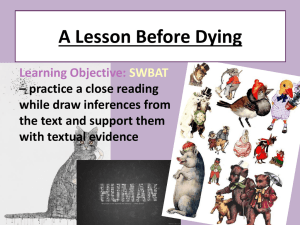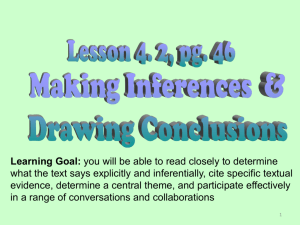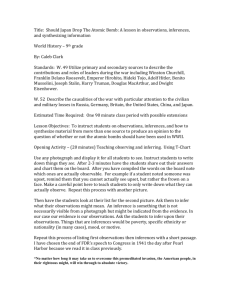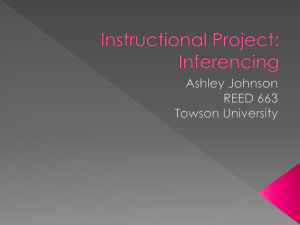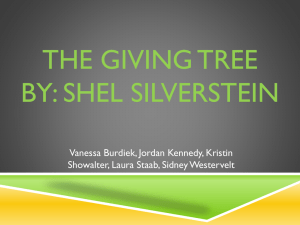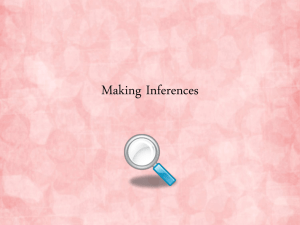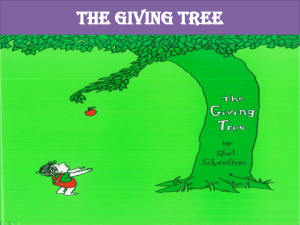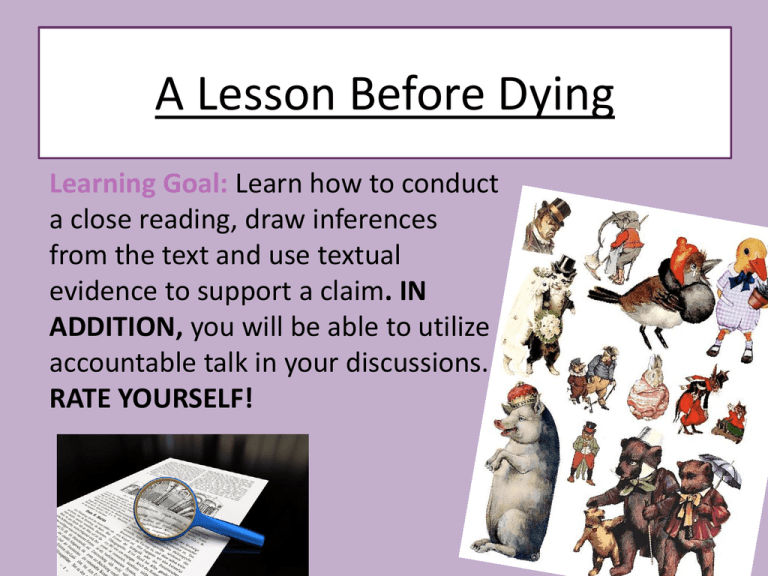
A Lesson Before Dying
Learning Goal: Learn how to conduct
a close reading, draw inferences
from the text and use textual
evidence to support a claim. IN
ADDITION, you will be able to utilize
accountable talk in your discussions.
RATE YOURSELF!
DO NOW
• MY CLAIM – Throughout
Fahrenheit 451, Montag
moves from being
dehumanized to being
human.
• Agree or refute with evidence
from the text. – 3 minutes
with a 2 minute pair/share
In order to answer that question, you
had to read closely, but what exactly is
a close reading?
Close reading is paying especially close
attention to what is printed on the page. It is
a much more subtle and complex process
than the term might suggest.
Turn & Talk – 3 mins.
How might an author’s choice of
words contribute to a close read?
Add to your response
Close reading involves playing
detective: looking at the work's
particular vocabulary, sentence
construction, patterns, and words
that convey imagery. While doing a
close read, you need to ask yourself,
What is the author implying?
Making Inferences
Figuring out what the author is
implying will require you to make
inferences.
• To infer requires that you guess the
probable meaning.
Making Inferences from a Cartoon
_______ 1.
_______ 2.
_______ 3.
_______ 4.
_______ 5.
The boy doesn’t like monkeys.
The boy has probably never seen animals in a zoo.
The father is angry with the boy.
The boy thinks the monkey is being punished.
The boy and his father go to the zoo often.
_______ 1.
_______ 2.
_______ 3.
_______ 4.
_______ 5.
Gulliver’s Travels is a true story.
The man on the ground recently ate lunch and is taking a nap.
The book has something to do with a journey.
The illustrated large man is likely an important character.
The story in the book takes place in modern times.
How did you do?
Did you figure out what the cartoonists were
implying? Turn your dice to indicate your level
of understanding.
Turn and talk to your partner –
What does it mean to infer?
To infer requires that you guess
the probable meaning.
PRACTICE - Chapter 1 page 3
I WAS NOT THERE, yet I was there. No,
I did not go to the trial, I did not hear the
verdict, because I knew all the time what it
would be. Still, I was there. I was there as
much as anyone else was there. Either I sat
behind my aunt and his godmother or I sat
beside them.
While doing a close read on the opening
of the novel, you’ll need to ask yourself…
1. What is the first thing you notice?
2. Do you notice any patterns in the text—repetitions,
contradictions, or similarities…?
3. What do the words suggest or imply?
In other words, what can you infer?
4. What is the mood?
5. How does the text make you react to or think about
Grant?
5 mins – 20 mins. total .
Shared Close Reading
• In groups of three or four, you will read the
first (very short) chapter of A Lesson Before
Dying.
• During this time, you will support or refute
my claim – In A Lesson Before Dying,
Jefferson is dehumanized. Agree or refute
with evidence from the text. Use your
worksheet to gather information.
REMINDER - While doing a close read,
you and your group will need to consider…
1. What is the first thing you notice?
2. Do you notice any patterns in the text—repetitions
and/or contradictions ?
3. What do the words suggest or imply? In other words,
what can you infer?
4. What is the mood?
5. How does the text make you react or think about
Grant, Jefferson, Miss Emma, and/or Jefferson’s attorney?
Looking Ahead…
• Reread chapter one and come to the next
class ready to discuss your close read.
• You will have an opportunity to briefly
discuss your reactions to the text.
• Be ready to present your findings to your
classmates.

